In the American Southwest, most traditional societies produced art that is highly repetitive and rarely depicts humans. The Mimbres culture is a striking exception. Around a thousand years ago, the people produced painted bowls that were shockingly sophisticated, highly inventive, and regularly depicted humans engaged in everyday and ceremonial activities. The hemispherical bowls were coil-made without the wheel. A thin white slip was applied to the interior of the clay body, over which designs were painted with mineral paint that fired black to brown to red depending on the vagaries of the open kilns they used. While jars and effigy vessels were occasionally made, most surviving vessels are bowls between 12 and 30 cm in diameter. Today they are in museum collections across the US, Mexico and beyond, although – with only a couple of exceptions – most only display a handful of bowls at a time. While a planned exhibition at the Art Institute of Chicago was recently postponed, the story of these unique objects is one that deserves to be shared with a wide public.
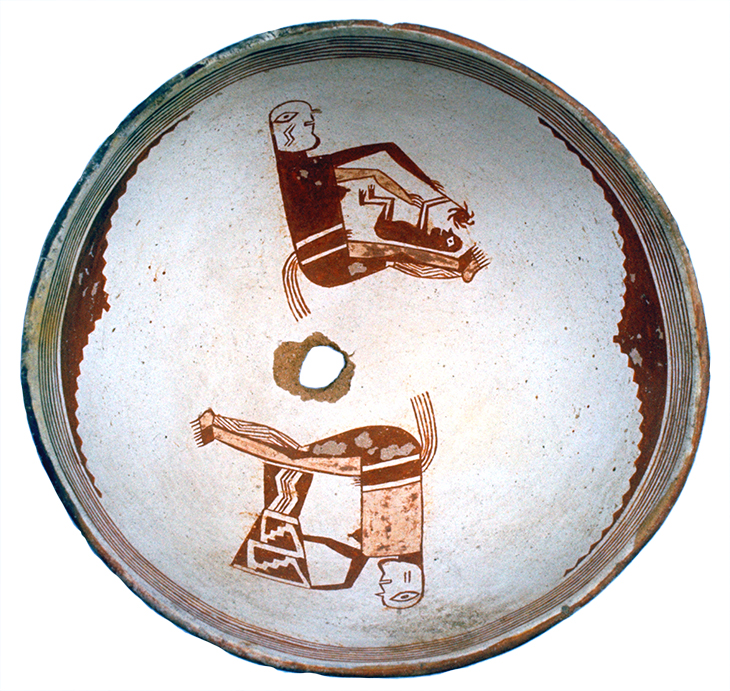
Painted bowl depicting two women with children (with a very rarely used tan second colour paint), Classic Mimbres period (1000–1130), New Mexico. Photo: the author
There were likely never more than 5,000 Mimbres people alive at any one time, inhabiting a few dozen towns, each with fewer than 200 people. The contemporary Chaco people to the north built towns with sandstone walls up to five stories tall. Mimbres houses were single-story, made of river cobble and adobe mud, and were far from impressive. Why they, of all people, should have made such sophisticated art from around 950–1130 AD remains a mystery. A case can be made that a few potter/painters, most likely women, were particularly skilful, and their work was appreciated for its singularity. A demand arose for their work, and these few women came to dominate the production of bowls – many villages stopped producing bowls entirely and traded for the ones they needed. Thus flourished and developed this short-lived artistic tradition.
Around 1130 AD, a cultural crisis took place in the Southwest. The great towns of Chaco and the humble towns of Mimbres ceased to be built and were soon abandoned. While the walls of the Chaco towns were still standing to be viewed by the first European explorers (and were always known to indigenous people), Mimbres towns fell into low mounds essentially unrecognised by the unrelated Apache Indians, the Hispanic farmers, and the Anglo ranchers until they were rediscovered 100 years ago. Most bowls that have been found had been interred with individuals who were buried under the floors of rooms in the houses or in courtyards. The bowls often were deliberately broken into shards or were symbolically broken by punching a hole in the bottom when interred. To date, more than 10,000 bowls have been recovered. About a third of them depict animals and/or people interacting. It is the great variety of animals and interaction scenes that garner many people’s attention, but it is the inventive geometric designs that seem to represent the height of artistic sensitivity and pictorial sophistication.
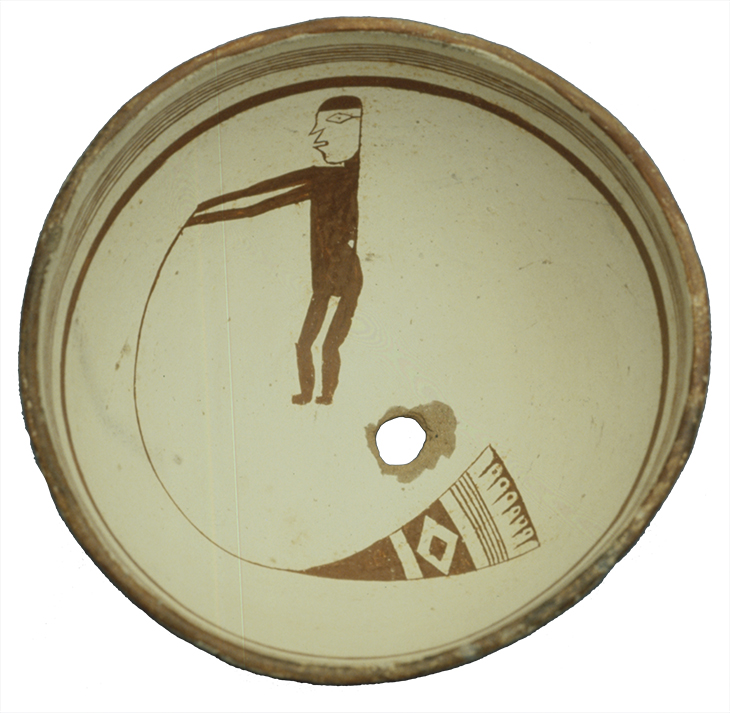
Painted bowl with human figure and probable bullroarer, Classic Mimbres period (1000–1130), New Mexico. Maxwell Museum, University of New Mexico. Photo: the author
The Pueblo people in the Southwest are societies who traditionally lived in compact towns (pueblos in Spanish) and practiced maize, beans, and squash agriculture. Most people consider them related to the Mimbres people. However, the three geographically closest modern Pueblo communities – Hopi, Acoma, and Zuni – are hundreds of miles away from the Mimbres territory, each speaks a language from one of three different language families, and nearly 1,000 years have passed since the Mimbres suddenly and inexplicably disappeared. Any cultural links are indirect and a great deal of time has passed. Nonetheless, after the first publications of Mimbres designs became available in the 1920s, several of the Pueblo women who made painted pottery used them as resources and deftly incorporated them into their art.
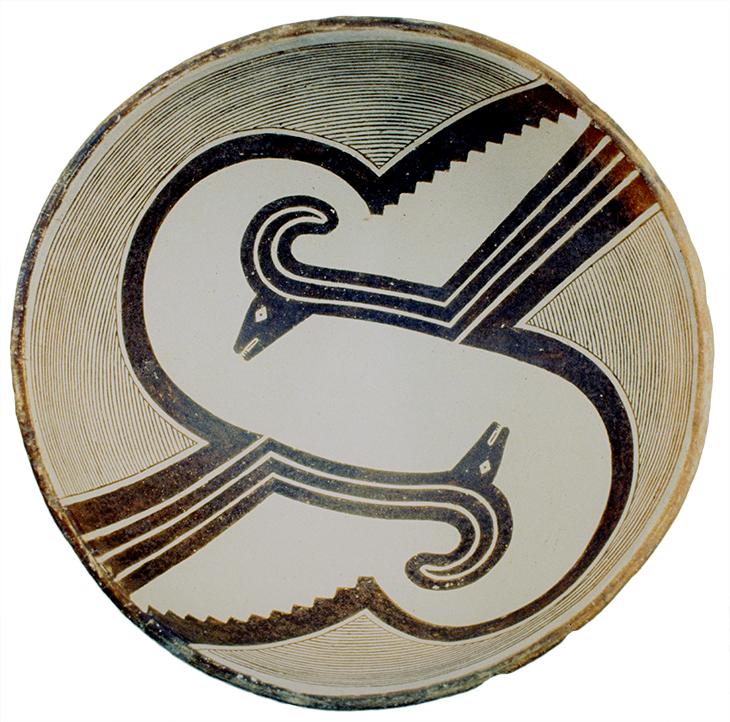
Painted bowl with abstract bighorn sheep heads, Classic Mimbres period (1000–1130), New Mexico. Maxwell Museum, University of New Mexico. Photo: the author
Since then, Mimbres art has become an integral element in the art of the contemporary Southwest. The Santa Fe Railway featured Mimbres designs in its Mimbreno dining car china. From postcards to real-estate signs to highway markers, Mimbres-style animals appear everywhere. The question arises whether there is meaning in the ‘geometric’ design elements, and do the animal and human figures represent totems, stories or actual events? This has resulted in considerable unsubstantiated speculation. Another approach has been to ask Pueblo people today what the imagery means. This is a rather unfair question. The Vikings lived about the same time as the Mimbres, and their influence extended to Normandy, Ireland, and beyond. While it might be one thing to ask an Icelander to interpret some Viking art, would we expect modern people in France and the United Kingdom to be able to interpret Viking design motifs for us? Rather than asking ‘what does that zigzag line mean?’, a far more fruitful approach has been to listen and watch as Native artists interpret Mimbres art in accordance with their own experience and world view.
An excellent example is the famous Hopi artist Fred Kabotie (c. 1900–86), who painted in a flat, frameless style much like the Mimbres and who spent considerable time studying bowl designs, pointing out several bowls that he felt were attempts at perspective – a concept rare in the world and especially in the prehistoric Americas. Similarly, a small number of Acoma women who still make pottery in a traditional way have provided valuable insights into how the Mimbres people used materials to make paints and lay out their designs. Pueblo artists are every bit as fascinated by the Mimbres designs as everyone else and are very proud to use these images as part of a shared cultural heritage.
Steven LeBlanc is former director of collections at the Peabody Museum of Archaeology and Ethnology at Harvard University.
Unlimited access from just $16 every 3 months
Subscribe to get unlimited and exclusive access to the top art stories, interviews and exhibition reviews.

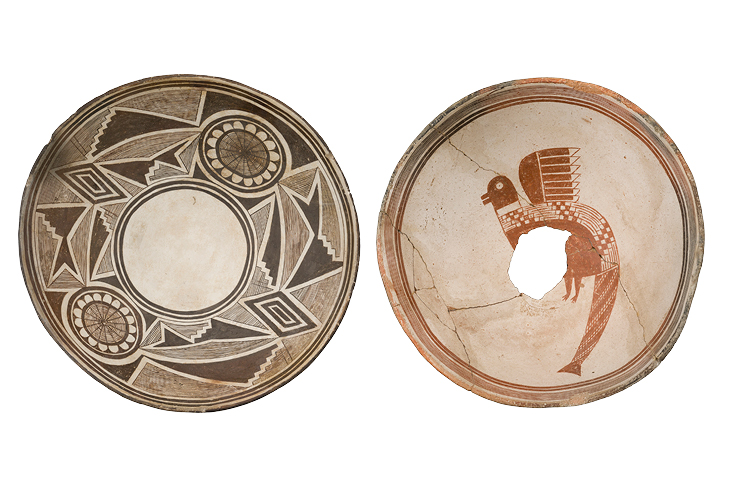
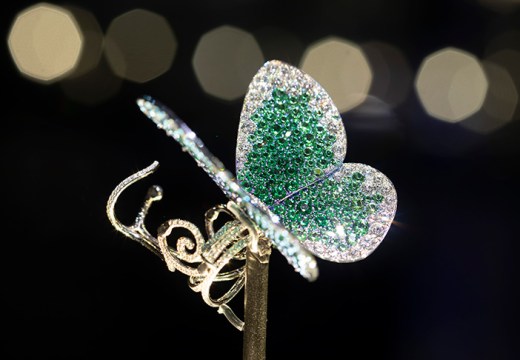











![Masterpiece [Re]discovery 2022. Photo: Ben Fisher Photography, courtesy of Masterpiece London](http://www.apollo-magazine.com/wp-content/uploads/2022/07/MPL2022_4263.jpg)
Why are fathers so absent from art history?